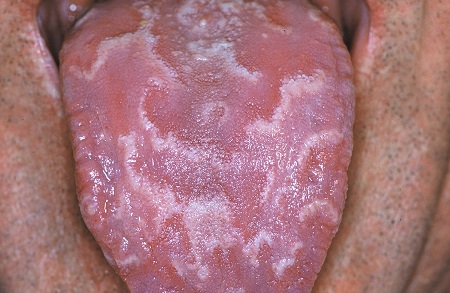Etiology
Fissured tongue has an unknown etiology, although heredity appears to play a role, and some suggest that fissured tongue might represent a polygenic trait or may be of autosomal dominant inheritance with incomplete penetrance.[13][Figure caption and citation for the preceding image starts]: Fissured tongue with grooves or fissures on the dorsal surfaceLmossabasha064 / CC-BY-SA-4.0 (https://creativecommons.org/licenses/by-sa/4.0/deed.en) [Citation ends].
Patients usually have fissured tongue from childhood, but the condition may become more prominent with increasing age.
Hairy tongue develops when the usual balance between keratin production and shedding through normal oral function is chronically disrupted with consequent elongation of the keratinized component of the filiform papillae that cover the tongue dorsum. Poor oral intake during illness, hyposalivation, or oral discomfort secondary to oral ulcerative conditions are examples of situations where keratin shedding is reduced. Various factors that may be associated with increased production of keratin include smoking, poor oral hygiene, tea and/or coffee drinking, and the use of oxidizing mouthwashes.[7][8][10] The hairy appearance is caused by retention of keratin at the tips of the filiform papillae.[14] It presents as diffuse hair-like projections especially in the midline of the dorsal tongue. In an otherwise healthy person, hairy tongue does not signify underlying systemic disease. In non-healthy people who are immunosuppressed or HIV-positive, the differential includes oral hairy leukoplakia caused by the Epstein-Barr virus, which typically involves the lateral borders of the tongue.
Geographic tongue is a common benign clinical condition of unknown etiology. Several associations between geographic tongue and other diseases have been postulated; however, the most significant one is with psoriasis. Indeed the two conditions share similar histopathologic features.[1][15][Figure caption and citation for the preceding image starts]: Geographic tongue, presenting with typical red areas surrounded by while scalloped bordersDimitrios Malamos/CC BY 4.0 (https://creativecommons.org/licenses/by/4.0/deed.en) [Citation ends].
Pathophysiology
Fissured tongue has an unknown pathophysiology.
In hairy tongue, the hypertrophy of the filiform papillae on the dorsal tongue may be due to lack of mechanical debridement through normal oral function and/or due to reactive overgrowth of the keratinized tips of the filiform papillae.
Poor oral intake during illness, hyposalivation, or oral discomfort secondary to oral ulcerative conditions are examples of situations where mechanical debridement and shedding of keratin from the filiform papillae are reduced.
The color of the papillae ranges from yellow to brown-black, depending upon certain food products and increased consumption of products such as tobacco, coffee, and tea.
The erythematous component of geographic tongue is a result of the absence of the filiform papillae. The lesions begin as small white patches and as they extend or migrate they develop a central red atrophic zone.[16]
Use of this content is subject to our disclaimer